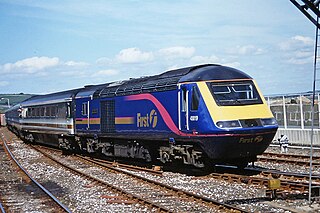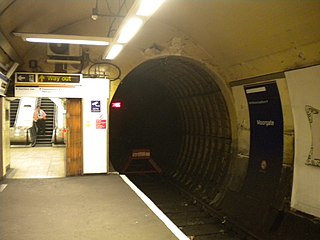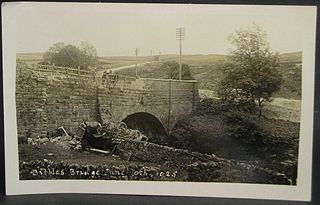
The Ufton Nervet rail crash occurred on 6 November 2004 when a train collided with a stationary car on a level crossing on the Reading–Taunton line near Ufton Nervet, Berkshire, England. The collision derailed the train, and seven people—including the drivers of the train and the car—were killed.

The Moorgate tube crash occurred on 28 February 1975 at 8:46 am on the London Underground's Northern City Line; 43 people died and 74 were injured after a train failed to stop at the line's southern terminus, Moorgate station, and crashed into its end wall. It is considered the worst peacetime accident on the London Underground. No fault was found with the train, and the inquiry by the Department of the Environment concluded that the accident was caused by the actions of Leslie Newson, the 56-year-old driver.

A buffer stop, bumper, bumping post, bumper block or stopblock (US), is a device to prevent railway vehicles from going past the end of a physical section of track.

Over the latter years of the 19th and early years of the 20th centuries, Penistone in Yorkshire gained a name as an accident black-spot on Britain's railway network; indeed, it could be said to hold the title of the worst accident black-spot in the country. The main line through the town was the Woodhead route of the Manchester, Sheffield and Lincolnshire Railway between Sheffield Victoria and Manchester, London Road. The line was heavily graded with a summit some 400 yards inside the eastern portal of the Woodhead tunnel.

A retarder is a device used to augment or replace some of the functions of primary friction-based braking systems, usually on heavy vehicles. Retarders serve to slow vehicles, or maintain a steady speed while traveling down a hill, and help prevent the vehicle from "running away" by accelerating down the hill. They are not usually capable of bringing vehicles to a standstill, as their effectiveness diminishes as vehicle speed lowers. They are usually used as an additional "assistance" to slow vehicles, with the final braking done by a conventional friction braking system. As the friction brake will be used less, particularly at higher speeds, their service life is increased, and since in those vehicles the brakes are air-actuated helps to conserve air pressure too.

On the evening of 4 December 1957, two trains crashed in dense fog on the South Eastern Main Line near Lewisham in south-east London, causing the deaths of 90 people and injuring 173. An electric train to Hayes had stopped at a signal under the bridge, and the following steam train to Ramsgate crashed into it, destroying a carriage and causing the bridge to collapse onto the steam train. The bridge had to be completely removed; it was over a week before the lines under the bridge were reopened, and another month before the bridge was rebuilt and traffic allowed over it.

The Gillingham bus disaster occurred outside Chatham Dockyard, Kent on the evening of 4 December 1951. A double-decker bus ploughed into a company of fifty-two young members of the Royal Marines Volunteer Cadet Corps, aged between nine and thirteen. Twenty-four of the cadets were killed and eighteen injured; at the time it was the highest loss of life in any road accident in British history, until it was surpassed by the 1975 Dibbles Bridge coach crash which killed 33.

The RegioSwinger is a tilting diesel multiple unit (DMU) passenger train used for fast regional traffic on unelectrified lines.

The Boys in Red accident occurred on January 12, 2008, just outside the city of Bathurst, New Brunswick, Canada. A semi-trailer truck and a van carrying the basketball team from Bathurst High School collided, which killed seven students, the wife of the coach, and injured four other occupants in the van. It was the deadliest transportation accident in New Brunswick since 1989, when a logging truck tipped onto a hayride in Cormier Village, killing 13. It was the deadliest bus accident involving a sports team in Canada until the Humboldt Broncos bus crash in April 2018.

The rampe de Laffrey is a section of France's Route nationale 85, itself part of the route Napoléon. It connects the communes of Laffrey and Vizille in the department of Isère, about 15 kilometers southeast of Grenoble.

The Sierre coach crash occurred on 13 March 2012 near Sierre, Switzerland, when a coach carrying school teachers and pupils crashed into a wall in the Sierre Tunnel. Of the 52 people on board, 28 were killed in the crash, including both drivers, all four teachers, and 22 of the 46 children. The other 24 pupils, all aged between 10 and 12, were injured, including three who were hospitalised with severe brain and chest injuries.

On 10 June 1925, a coach crashed at the bottom of a steep hill at Dibbles Bridge, near Hebden in North Yorkshire, England. Seven people were killed and 11 others injured.

On 9 November 2016, a tram operated by Tramlink derailed and overturned on a sharp bend approaching a junction. Of a total 69 passengers, there were seven fatalities and 62 injured, 19 of whom sustained serious injuries. This was the first tram incident in the United Kingdom in which passengers died since 1959.

The 2017 Verona bus crash was a traffic collision that happened around midnight at night of 20–21 January 2017 on the A4 motorway at San Martino Buon Albergo, near Verona, in Italy. A coach that was transporting Hungarian high school students and their teachers back from a skiing trip in France collided with the highway traffic barrier, crashed into a bridge pylon, and then caught fire.
A tourist bus carrying 50 passengers, mostly students from Bestlink College of the Philippines in Quezon City who were on a field trip, lost its brakes and crashed into an electricity pole in Tanay, Rizal, killing 15 passengers including the driver. The accident uncovered lax regulations on safety of students on educational trips in the Philippines and prompted the Commission on Higher Education and Department of Education to issue moratoriums on field trips for the 2016–17 school year.

At around 17:00 BST on 11 April 2004, a double-decker bus was involved in a collision with a car and a number of pedestrians outside the Fantasy Island amusement park on Sea Lane in Ingoldmells, Lincolnshire. The collision killed five pedestrians and injured six more.
















